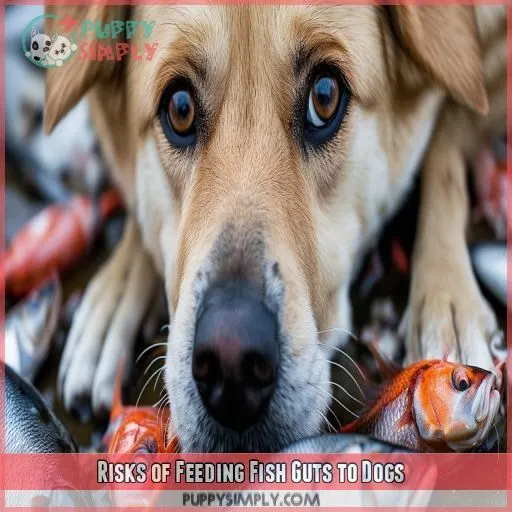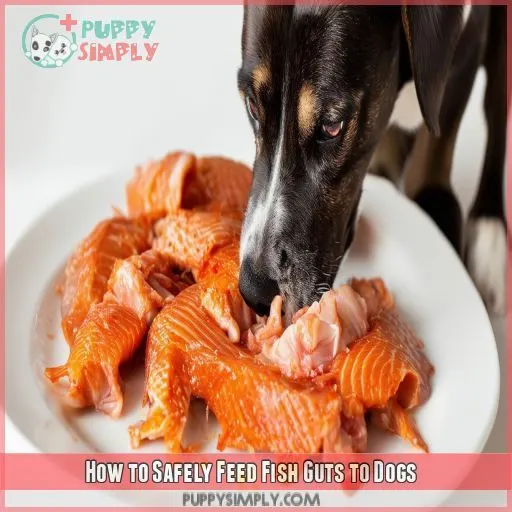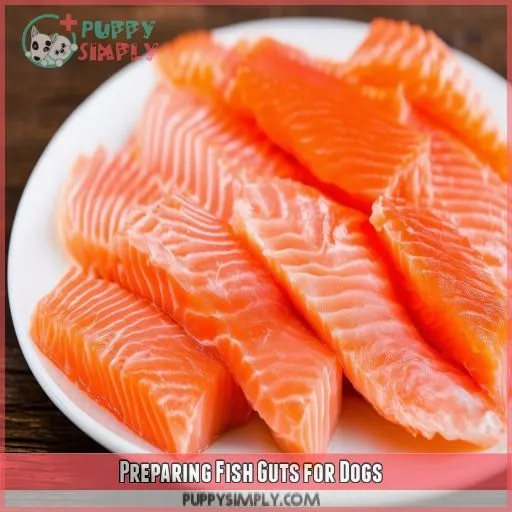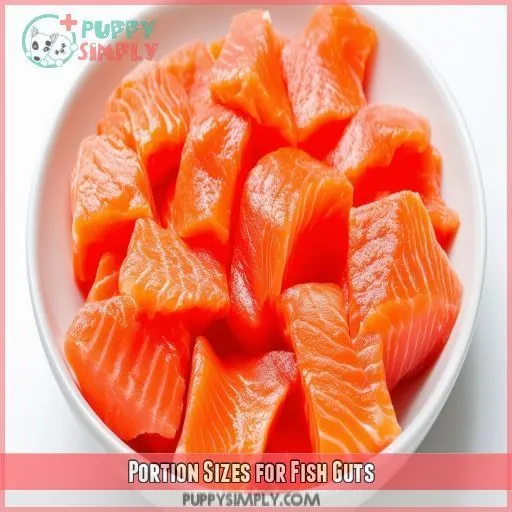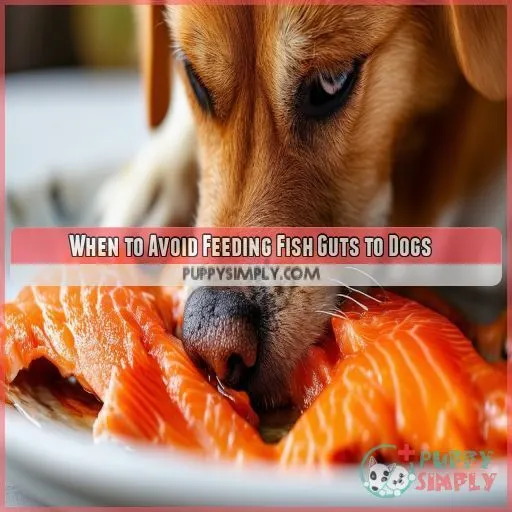This site is supported by our readers. We may earn a commission, at no cost to you, if you purchase through links.
 Yes, dogs can eat fish guts as a healthy treat, but proper preparation is essential.
Yes, dogs can eat fish guts as a healthy treat, but proper preparation is essential.
Fish guts are packed with protein, omega-3 fatty acids, and essential vitamins and minerals that can benefit your pup’s skin, coat, and overall well-being.
However, they also pose risks like parasites, bacteria, and choking hazards if not handled correctly.
To safely feed fish guts, clean them thoroughly, cook until fully cooked, and introduce them gradually in small portions.
Pay attention to any allergic reactions or digestive issues.
By taking the right precautions, you’ll let your furry friend enjoy the nutritious goodness of fish guts without compromising their health.
But don’t stop here – there’s more you need to know.
Table Of Contents
- Key Takeaways
- Can Dogs Eat Fish Guts?
- Nutritional Value of Fish Guts for Dogs
- Risks of Feeding Fish Guts to Dogs
- How to Safely Feed Fish Guts to Dogs
- Preparing Fish Guts for Dogs
- Portion Sizes for Fish Guts
- Alternatives to Fish Guts
- When to Avoid Feeding Fish Guts to Dogs
- Frequently Asked Questions (FAQs)
- Conclusion
Key Takeaways
- Fish guts aren’t exactly fine dining for Fido – they could be harboring nasty stowaways like parasites, bacteria, and even the odd fish bone that could turn your pup’s snack time into an emergency vet visit.
- If you’re hellbent on serving up some fishy innards, make sure you give them a good scrub down and cook them to the nines. That’ll help kick any unwanted guests to the curb before they have a chance to wreak havoc on your furry friend’s insides.
- Moderation is key, captain – too many fish guts could lead to some serious gastrointestinal drama that’ll have your dog feeling more queasy than a landlubber on a storm-tossed sea. A few bites here and there should keep them shipshape.
- At the end of the day, there are plenty of other ways to get those omega-3s and lean proteins into your pooch’s diet without risking a run-in with Mr. Parasite or Madam Salmonella. Why not stick to boneless fish fillets and save the guts for the gulls?
Can Dogs Eat Fish Guts?

Dogs should avoid eating fish guts. Fish guts may contain high levels of mercury, which can lead to mercury poisoning in dogs (Source). Additionally, raw fish guts may harbor harmful parasites and bacteria that can cause digestive problems and stomach upset .
If you want to incorporate fish into your dog’s diet, stick to lean, cooked, deboned fish like salmon or whitefish .
Avoid feeding raw fish or fish guts altogether.
If your dog has fish allergies, consult your veterinarian before introducing any new proteins .
For a safe omega-3 boost, consider fish oil supplements formulated for dogs .
Nutritional Value of Fish Guts for Dogs
Fish guts offer several nutritional benefits for dogs due to their rich content of essential nutrients:
- Protein: Supports muscle growth and repair.
- Omega-3 fatty acids: Reduce inflammation and support skin and coat health.
- Vitamin D: Aids in calcium absorption, promoting bone health.
- Minerals: Such as iodine and selenium, are important for thyroid function and immune system support.
- Low fat: Fish guts are a lean protein source, helping maintain healthy weight.
Despite the nutritional benefits, always make sure proper fish gut preparation to mitigate potential safety risks such as bones, parasites like flukes and roundworms, and contaminants like mercury. Always choose the safest preparation methods to protect your dog’s health.
Risks of Feeding Fish Guts to Dogs
You shouldn’t feed fish guts to your dog due to the high risk of parasites and harmful bacteria they may contain. Fish guts can also pose a choking hazard because of their shape, size, and potential to block your dog’s airway.
Parasites
Parasites like flukes, tapeworms, and roundworms lurk in raw fish, potentially causing salmon poisoning in dogs. Freeze fish at -4°F for 7 days to eliminate parasites. Omega-3s and vitamin D are great, but heavy metal toxicity from parasites is not (Source).
Bacteria
Raw fish can harbor harmful bacteria like salmonella, making dogs sick. Symptoms include vomiting, diarrhea, and fever. Canned fish is safer, but check for bones. Cook fish thoroughly to kill bacteria and parasites. Consult your vet before feeding fish guts to your dog .
Choking Hazard
Fish guts pose a choking hazard for dogs due to their small, sharp bones. Bones in guts can lodge in the throat, stomach or intestines, requiring emergency vet care. Avoid this risk by discarding guts and feeding only boneless fish flesh.
| Bone Size | Bone Shape | Bone Density | Bone Location | Bone Texture |
|---|---|---|---|---|
| Small | Sharp | Brittle | Scattered | Irregular |
How to Safely Feed Fish Guts to Dogs
To safely feed fish guts to your dog, take precautions to prevent parasites and make sure proper digestion.
First, thoroughly clean the guts to remove any visible parasites or debris.
Next, cook the guts until they reach an internal temperature of 145°F (62.8°C) to kill any harmful bacteria or parasites.
Finally, introduce fish guts gradually into your dog’s diet, starting with small portions to avoid digestive upset.
Gradually increase the amount over time as your dog’s body adjusts.
Preparing Fish Guts for Dogs
If you plan to feed fish guts to your dog, proper cleaning and cooking are essential. To clean the guts, thoroughly rinse them under cool running water to remove any debris or blood clots, then pat them dry with a clean paper towel.
Cleaning
Thoroughly clean fish guts to remove dirt, bacteria, and parasites. Rinse under cold running water, pat dry with paper towels. Discard any damaged or discolored parts. Store cleaned guts in an airtight container in the fridge for up to 3 days or freeze for longer storage. Proper hygiene guarantees your dog’s health and safety when feeding fish guts.
Cooking
To safely prepare fish guts for your dog, thoroughly cook them until they reach an internal temperature of 165°F.
This kills any harmful bacteria.
Avoid seasoning the guts, as many spices can upset your pup’s stomach.
Cooked fish guts provide a nutritious boost of protein, vitamins, and minerals to your dog’s diet when fed in moderation as part of a balanced meal plan.
Portion Sizes for Fish Guts
Now that you know how to safely prepare fish guts for your canine companion, it’s essential to understand appropriate portion sizes.
Moderation is key when incorporating this nutrient-dense food into your dog’s diet.
As a general rule, fish guts should make up no more than 10% of your dog’s total caloric intake (Source).
Portion sizes will vary based on your dog’s size, age, and activity level.
A good starting point is 1-2 tablespoons per 20 pounds of body weight, served 2-3 times per week .
Always introduce fish guts gradually and monitor for any digestive upset or allergic reactions.
Consult with your veterinarian to determine the ideal portion size for your individual dog based on their unique nutritional needs and health status.
Alternatives to Fish Guts
Looking for alternatives to fish guts for your dog? Consider these options to provide similar nutritional benefits:
- Fish Heads: Rich in nutrients, but make certain they’re free of sharp bones to avoid choking hazards .
- Fish Skin: Contains omega-3 fatty acids, supporting a healthy coat and skin. Make certain to cook it thoroughly to eliminate parasites and bacteria .
- Fish Liver: High in vitamins A and D, but feed in moderation to prevent hypervitaminosis A .
- Fish Scraps: Can include non-bone parts like cooked fins or tails; be cautious of potential choking threats and remove any small bones .
When to Avoid Feeding Fish Guts to Dogs
While fish guts can provide nutritional benefits, there are certain situations where it’s best to avoid feeding them to your canine companion.
If your dog has a sensitive stomach or is prone to digestive issues, the high fat content in fish guts may cause discomfort or diarrhea.
Additionally, some dogs may develop allergic reactions to fish, leading to skin irritation or gastrointestinal distress.
Ethical concerns may also arise if the fish weren’t sourced sustainably or humanely.
Finally, the environmental impact of feeding raw fish guts should be considered, as improper disposal can harm local ecosystems.
Always consult with your veterinarian before introducing fish guts into your dog’s diet to verify it aligns with their individual health needs and your personal values.
Frequently Asked Questions (FAQs)
Do dogs eat fish guts?
Around 10% of dogs may ingest fish guts if given access. However, you should avoid feeding fish guts to your furry friend to prevent potential health risks like obstruction or food poisoning from bacteria and parasites.
What part of a fish can a dog not eat?
You should never feed your dog fish bones, guts, or shells. These pose a serious choking hazard and can puncture their digestive tract. Stick to boneless, skinless fish fillets for a safe, nutritious treat.
Can dogs eat fish scraps?
Picture some scales and a few fish bones scattered on your kitchen counter — that’s what we’d call fish scraps. While you mightn’t want to serve them up for dinner, they can actually provide a tasty, nutritious treat for your pup!
Can dogs eat cooked guts?
You shouldn’t feed dogs cooked guts or internal organs. They can contain harmful bacteria or toxins if not thoroughly cooked. It’s best to avoid guts altogether and stick to lean, boneless fish fillets for a safe, nutritious treat.
Can dogs eat fish heads?
Just say no to Fido eating fish heads. Imagine your pup choking on sharp fins or bones – not a fun game of catch! Play it safe by steering clear of those skulls on your dog’s dish. Stick to boneless fillets for your furry pal’s oceanic treats.
Is it safe to feed raw fish to dogs?
You shouldn’t feed raw fish to dogs – it can contain harmful parasites and bacteria like salmonella. Cook fish thoroughly to kill any pathogens before serving for a safer, healthier treat.
What are the benefits of feeding fish to dogs?
Feeding fish offers several benefits for dogs: lean protein, omega-3s to reduce inflammation, vitamin D for calcium absorption, and variety for dogs with allergies. Thoroughly cook fish to eliminate potential bacteria and parasites.
What types of fish are best for dogs?
You should feed your dog whitefish, salmon, herring, or walleye. These fish are packed with protein, omega-3s, and nutrients that support your pup’s overall health.
Can dogs eat fish bones?
Feeding fish bones to dogs is never advisable. The brittle bones can splinter, potentially puncturing your dog’s mouth, throat, or intestines, causing severe injury. For your furry friend’s safety, be diligent in removing all bones before serving any fish.
Conclusion
Fish guts can provide valuable nutrition for your canine companion. However, like any treat, moderation and proper preparation are key.
Just as a ship navigates treacherous waters with care, you must steer clear of potential dangers like parasites and choking hazards when feeding fish guts.
Follow safe handling steps.
Introduce them gradually.
Watch for adverse reactions.
With vigilance, your pup can enjoy the benefits of fish guts as an occasional, protein-packed snack.


